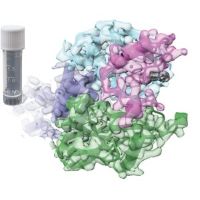Specification
| Organism | Serratia marcescens |
| Expression Host | Yeast |
| Tag Info | N-terminal 6xHis-tagged |
| Purity | Greater than 85% by SDS-PAGE |
| Uniprot ID | P18955 |
| Gene Names | hns |
| Alternative Names | Histone-like protein HLP-II |
| Expression Region | Full Length of Mature Protein(2-135aa ) |
| Molecular Weight | 17.5 kDa |
| Protein Sequence | SERLKILNNIRTLRAQARECTLETLEEMLEKLEVVVNERREEDSQAQAEIEERTRKLQQYREMLIADGIDPNELLQTMAANKAAGKAKRARRPAKYQYKDENGELKTWTGQGRTPAVIKKAIEEQGKSLDDFLL |
| Form | Liquid or Lyophilization |
| Buffer | The default storage buffer is Tris/PBS-based buffer, 5%-50% glycerol if the delivery form is liquid. The lyophilization buffer is Tris/PBS-based buffer, 6% Trehalose, pH 8.0 if the delivery form is lyophilized powder. Please contact us if you have any special requirment. |
| Reconstitution | Please reconstitute protein in deionized sterile water and we recommend that briefly centrifuge thevial prior to opening the vial .We recommend aliquot for long-term storage at -20℃/-80℃. |
Background
| Relevance | H-NS binds tightly to ds-DNA, increases its thermal stability and inhibits transcription. It also binds to ss-DNA and RNA but with a much lower affinity. H-NS has possible histone-like function. May be a global transcriptional regulator through its ability to bind to curved DNA sequences, which are found in regions upstream of a certain subset of promoters. It plays a role in the thermal control of pili production. It is subject to transcriptional auto-repression. It binds preferentially to the upstream region of its own gene recognizing two segments of DNA on both sides of a bend centered around -150 (By similarity). |
| Involvement in Disease | |
| Subcellular Location | Cytoplasm, nucleoid |
| Protein Families | Histone-like protein H-NS family |
| Tissue Specificity | hns |
QC Data
| Note | Please contact us for QC Data |
| Product Image (Reference Only) |  |

